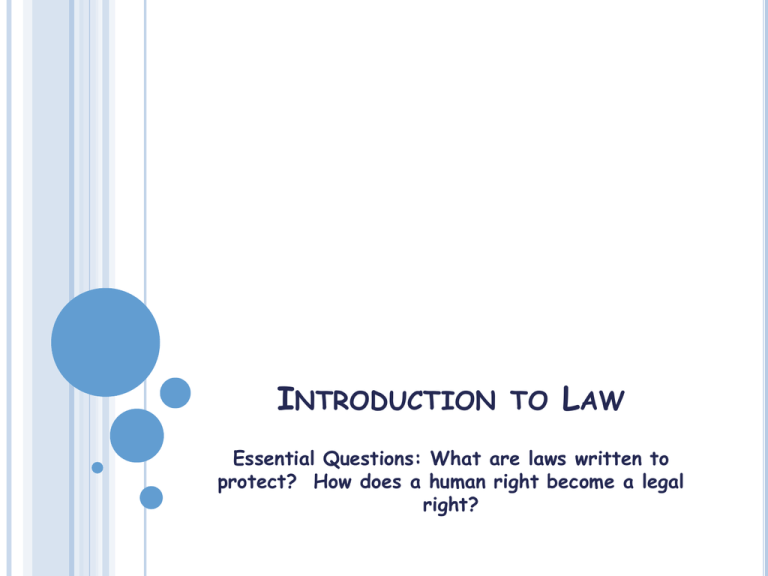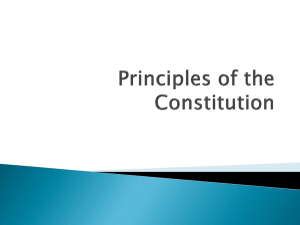Introduction to Law
advertisement

INTRODUCTION TO LAW Essential Questions: What are laws written to protect? How does a human right become a legal right? WHAT IS LAW? The rules and regulations made and enforced by government that regulate the conduct of people within a society. Every society has some set of laws, whether written or unwritten because without rule and order, there would be confusion and disorder. In order for a legal system to be effective, laws should be respected by all people. We call this the “rule of law”. This means that all people, from average citizens to the president of the United States, have to abide by all laws. No one is above the law. POLLEVERYWHERE What does the “rule of law” mean? HUMAN RIGHTS Human rights are rights individuals have just because they are human beings (inherent rights). Laws should be in place to prevent the government as well as individuals from violating another person’s rights. HUMAN RIGHTS The United Nations has written a statement of basic human rights called the Universal Declaration of Human Rights (UDHR) and it has been signed by almost every country in the world. It guarantees the following rights: Right to liberty (freedom) Right to education Right to political freedom Right to religious freedom Right to economic well-being Right to freedom from torture Right to participate in the governmental process POLLEVERYWHERE Why should laws be put into place? HUMAN RIGHTS V. LEGAL RIGHTS For human rights to actually be legal rights in the United States, there would have to be some type of law written protecting them. Many of the rights listed in the UDHR are included in our Constitution and Bill of Rights, as well as federal, state, and local laws. For example, the right to an education is not guaranteed by Federal law. It is however, guaranteed by the state constitution; therefore, it is the legal right of all children in NC to receive a free education. If the Supreme Court makes a ruling about any Constitutional issue all other courts (state and federal) must follow the ruling (ex: same sex marriage) CONSTITUTIONAL FRAMEWORK: The highest law in the United States is the United States Constitution. Federalism – division of governmental power between federal, state, and local government Limited Government – the federal government is limited by the Constitution, and many powers are denied to the federal government and instead given to state governments. Separation of Powers – division of lawmaking powers between the three branches of government – legislative branch makes the laws, executive enforces, and judicial interprets POLLEVERYWHERE What must happen for human rights to be legal in the United States? CONSTITUTIONAL FRAMEWORK: Checks and Balances – prevents one branch from becoming more powerful than other branches – each branch can check some of the actions of the other two branches and overrule them if necessary Judicial Review – an example of a check and balance, the judicial branch can review the decisions of other branches Constitution is a Living Document– The Founding Fathers recognized the importance for the Constitution to be able to change and adapt over time. Because of this, they included the Amendment process so that we may change the Constitution if necessary. This has allowed the US Constitution to be the longest-lasting written constitution in the world. . POLLEVERYWHERE Why is federalism important to the framework of our government? WHY DO WE HAVE LAWS? Laws are intended to do each of the following: Protect basic human rights Promote fairness Help resolve conflicts Promote order and stability Represent the will of the majority Protect the rights of the minority LEGAL VALUES: Moral: fundamental questions of right and wrong Economic: accumulation, preservation, use and distribution of wealth Political: relationship between government and individuals Social: important issues to society (social values) POLLEVERYWHERE Why do we have laws? LEGAL RESPONSIBILITIES Many rights are guaranteed to American citizens through the Constitution, Bill of Rights, and other laws that have been passed throughout the years. Citizens must understand that in order to protect our legal rights, we have certain responsibilities. If we do not abide by these responsibilities, we risk having our rights revoked. LEGAL RESPONSIBILITIES Examples: Right: Voting – Responsibility: being informed and politically active Right: Freedom of Religion – Responsibility: being tolerant of religions different from your own Right: Trial by Jury – Responsibility: willing to serve as a member of a jury POLLEVERYWHERE List 3 rights teenagers have today.







